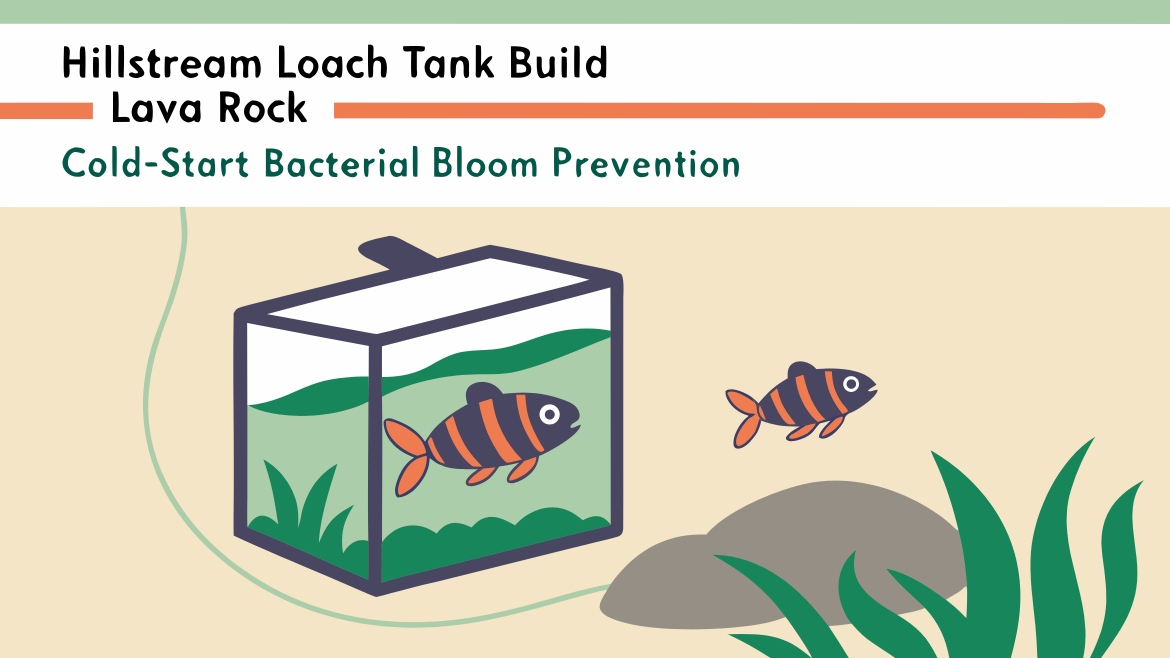Hillstream loaches are mesmerizing bottom dwellers known for their streamlined bodies, sucker-like mouths, and love of high-flow environments. Aquarium hobbyists often replicate their natural fast-flowing river habitats through river-tank builds — setups with strong water currents, smooth stones, and ample oxygenation.
A common and often underestimated challenge in these builds, especially during cold starts (aquariums set up without pre-seeded filter media), is bacterial bloom. This cloudy water phenomenon can stress fish, block light penetration, and disrupt tank stability. When lava rock is used for aquascaping and biological filtration, the dynamics of bacterial bloom prevention become even more nuanced.
In this guide, we’ll explore how to prevent bacterial blooms in a cold-started river tank for hillstream loaches, specifically when using lava rock as a core material.
Understanding the Cold Start in River-Tank Builds
What Is a Cold Start?
A cold start refers to starting an aquarium without mature, beneficial bacteria colonies already established on filter media, substrate, or decorations. Unlike a “fishless cycle” with seeded media, cold starts rely entirely on newly forming bacterial populations.
Why Hillstream Loach Tanks Are Different
Hillstream loach river-tanks typically have:
- High water flow (which can disperse bacteria faster)
- Cooler temperatures (beneficial bacteria grow slower)
- Minimal organic debris (since setups are rocky rather than planted soil tanks)
These factors make bacterial colonization slower and initial blooms more likely.
The Science Behind Bacterial Blooms
Bacterial blooms occur when heterotrophic bacteria multiply rapidly in the water column, feeding on dissolved organic matter. In a new tank:
- Uneaten food, fish waste, and decomposing organic material feed bacteria.
- Without established nitrifying bacteria, ammonia and nitrite spikes occur.
- The bloom can appear as a white or cloudy haze in the water.
Why Lava Rock Plays a Double Role
Advantages of Lava Rock
- Highly porous: Offers enormous surface area for beneficial bacteria colonization.
- Lightweight and versatile: Easy to stack for river-tank scaping.
- Long-term stability: Once colonized, it supports a robust nitrogen cycle.
Potential Challenges
- In a cold start, lava rock can initially trap fine debris, which becomes a nutrient source for bloom-causing bacteria.
- Its open pores can harbor heterotrophic bacteria before nitrifying bacteria take over.
- Strong flow may push this bacterial matter into the water column, increasing cloudiness.
Step-by-Step Bacterial Bloom Prevention Strategy
1. Pre-Soak and Pre-Rinse Lava Rock
- Rinse thoroughly under running water.
- Soak in dechlorinated water for 3–5 days, changing water daily to remove dust and trapped debris.
- Optional: Soak in a mild potassium permanganate or hydrogen peroxide solution (then rinse thoroughly) to sterilize surfaces.
2. Seed the Rock Before Setup
If possible:
- Place lava rock in an established aquarium or sump for 2–4 weeks before the build.
- Alternatively, use bottled nitrifying bacteria and drip-dose over the rock during pre-soak.
3. Control the Organic Load
- Avoid adding fish immediately in a cold start.
- Introduce fish food very sparingly or not at all until ammonia-oxidizing bacteria are detected.
- Use sinking algae wafers for initial bacterial feeding rather than protein-rich pellets.
4. Maintain High Oxygen and Flow
Hillstream loaches require strong current — this also benefits bacterial balance:
- Use a powerhead or river manifold system to keep water oxygen-rich.
- Aerate heavily during the early cycling stage.
5. Employ Mechanical Filtration
- Use fine filter floss or sponge to trap floating debris before it decomposes.
- Rinse mechanical media every 2–3 days during the first month.
6. Light Management
- Keep lights dim or off during the initial cycling to avoid encouraging opportunistic microbes and algae.
7. Test Water Frequently
Key parameters to monitor:
- Ammonia (should stay under 0.5 ppm for fish safety)
- Nitrite (peaks later in the cycle)
- Nitrate (rises as cycle progresses)
- Cloudiness level (visual inspection daily)
Introducing Hillstream Loaches Safely
- Only add hillstream loaches after ammonia and nitrite are 0 ppm for at least 7 days.
- Start with a small group to avoid sudden waste spikes.
- Feed lightly — they will graze on biofilm naturally forming on rocks.
Advanced Tips for Bloom Prevention
Use a Two-Stage Media Setup
Combine lava rock in the sump or filter with ceramic media for faster bacterial colonization.
Add Biofilm Sources
In a hillstream loach tank, a healthy green/brown biofilm on rocks is beneficial. You can “season” rocks in a separate tub under light to build algae before adding them to the tank.
Employ a UV Sterilizer
A small UV sterilizer can prevent free-floating bacterial overgrowth without harming beneficial bacteria on surfaces.
Infographic: Cold-Start Bloom Prevention Workflow
[Visual Suggestion] — Flowchart showing:
- Pre-rinse lava rock
- Seed with bacteria
- Cycle without fish
- Maintain oxygen & flow
- Monitor water
- Introduce loaches gradually
Frequently Asked Questions
Q1: How long does a bacterial bloom last in a cold-start river-tank?
A: Typically 3–10 days, but it can last longer if organic waste remains high.
Q2: Can I use bottled bacteria to skip the bloom?
A: It can shorten the bloom period, but proper cycling still takes weeks.
Q3: Does lava rock raise pH or hardness?
A: True volcanic lava rock is inert and does not alter water chemistry.
Q4: Should I clean lava rock during a bloom?
A: Avoid over-cleaning, but you can gently rinse in tank water if debris is excessive.
Conclusion
Preventing bacterial blooms in a cold-started hillstream loach river-tank with lava rock comes down to preparation, patience, and controlled cycling. By pre-rinsing and seeding your lava rock, managing organic load, and providing strong aeration and flow, you can achieve a crystal-clear, stable environment. This not only ensures the health of your hillstream loaches but also allows your river-tank build to thrive as a self-sustaining ecosystem.
References
- Spotte, S. (1992). Captive Seawater Fishes: Science and Technology. Wiley-Interscience.
- Noga, E. J. (2010). Fish Disease: Diagnosis and Treatment. Wiley-Blackwell.
- He, X. et al. (2017). “Bacterial community dynamics during aquarium cycling.” Aquatic Microbial Ecology, 80(1), 1-14.

